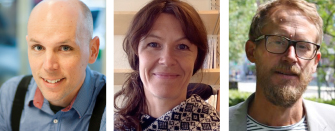Referens: Forskning om undervisning och lärande, vol 5, nr 1, ss. 6-25
Författare:
Daniel Bengtsson,
Maria Weiland,
Per Anderhag
Publiceringsdatum: 2017-03-06
Sammanfattning
Denna artikel presenterar resultat från en studie om elevers begreppsanvändning när de arbetar med kolets kretslopp i årskurs 7-9. Utifrån en lärargrupps tidigare erfarenheter, om de svårigheter elever har kring kolets kretslopp, utformades en lektion i syfte att stödja elevernas lärande och begreppsanvändning inom detta område. Lektionen innehöll två aktiviteter som var utformade så att eleverna skulle samtala tillsammans och förhoppningsvis ta stöd i relevant terminologi. Resultatet visade att uppgifterna stimulerade eleverna till att samtala om processer och fenomen relaterade till kolets kretslopp och i dessa samtal använde de ämnesspecifika begrepp. Koldioxid och fotosyntes användes dock inte för att precisera saker i samtalen och aktiviteterna tycks inte ha hjälpt dem med att koppla samman dessa fenomen med till exempel begreppen förmultning eller biogas. Resultatet visade att elevernas tidigare erfarenheter och sammanhanget har betydelse för elevernas möjlighet att utveckla kunskaper om kolets kretslopp. Artikeln diskuterar hur resultatet kan förstås och användas i undervisning om kolets kretslopp.
av Daniel Bengtsson, Maria Weiland & Per Anderhag
Nyckelord: begreppsanvändning, kolets kretslopp, NO, undervisning
Does silver contain carbon? A study on students’ use of scientific concepts when they work with the carbon cycle
Abstract
In this article we present findings from a study on students’ use of content specific concepts when working with the carbon cycle, in grade 7-9. Based upon a group of teachers’ previous experiences, of the difficulties that students often express about the carbon cycle, a lesson was designed with the purpose of supporting students’ learning and use of relevant concepts. Audio recordings from the lesson were transcribed and analysed using Practical Epistemological Analysis. Our findings showed that even if the students often used content specific concepts, such as carbon dioxide, they were rarely a tool for clarifying or specifying aspects of the carbon cycle. The results showed that the group activities supported the students to discuss the processes and phenomenon related to the carbon cycle and in their conversations they used subject-specific concepts. Although the student groups showed engagement with the tasks and often used relevant terminology, it is unclear whether and how the activities supported an understanding of the carbon cycle. Key concepts such as carbon dioxide and photosynthesis were rarely used to specify aspects of the carbon cycle, neither did the processes? become continuous with other concepts such as, for example, decay or natural gas when the students worked with the tasks. Our finding support previous studies that have demonstrated the importance of context and prior experiences of the students for what kind of learning is enabled. The article gives some suggestions on how the findings can be understood and used in relation to teaching about the carbon cycle.
Keywords: science, carbon cycle, concepts, teaching
Corresponding author: Daniel Bengtsson / daniel.bengtson@stockholm.se
